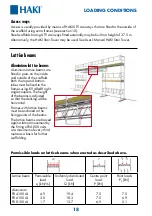
16
LOADING CONDITIONS
Bracing and tying-in
Each lift must be equipped with guardrail frames on the outside of the scaffolding 1.0 m
above the lift level and with decking.
The lower frames must all be fitted with guardrail frames both internally and externally.
Guardrail frames must always be fitted at the lowest possible level.
Each inside frame standard must be
tied to the facade or equivalent at
every 4th metre in height adjacent to
the corner of the frame. The lowest
tie must be fitted no more than 4.6 m
above ground level.
There must be ties that can carry
horizontal forces on at least every
5th pair of frame standards along the
scaffold and at every level of ties.
In addition, we recommend that the
scaffold always be anchored as high
up as possible.
Frames with brackets must be an-
chored at the top and at the bottom.
Cantilevered scaffolding and the lift
below the cantilevered scaffolding
must be anchored at every lift level.
Frames with lattice beams must be
anchored at the fixing points of the
beams.
The following estimated maximum
loads apply to scaffolding of this type
of 24 m in height in accordance with
EN 12811. Ties that can withstand
horizontal forces should be specified
for a load of 3.2 kN (3.3 kN) parallel
with the façade and 5.2 kN (5.0 kN)
perpendicular to the façade. Other
ties should be dimensioned for a load
of 2.5 kN (2.7 kN) perpendicular to
the façade. The values in parenthe-
ses refer to HAKI Ram in aluminium.
Where a scaffold is covered in
sheeting, the number of ties must be
increased to take account of wind
load. Separate calculations are there-
fore required.
Guardrails
Decked lifts must be provided with guardrail frames and toeboards if the fall height is
2.0 m or more.
Double handrails must be fitted to access stairways.
Ring bolt
Standard
Facade
Ring bolt
Tie rod tube
approx. 90°
Coupler
Coupler
Summary of Contents for 564
Page 1: ...HAKI AB 2014 USER S MANUAL...
Page 21: ...21 Notes...
Page 22: ...22...
Page 23: ...23...









































